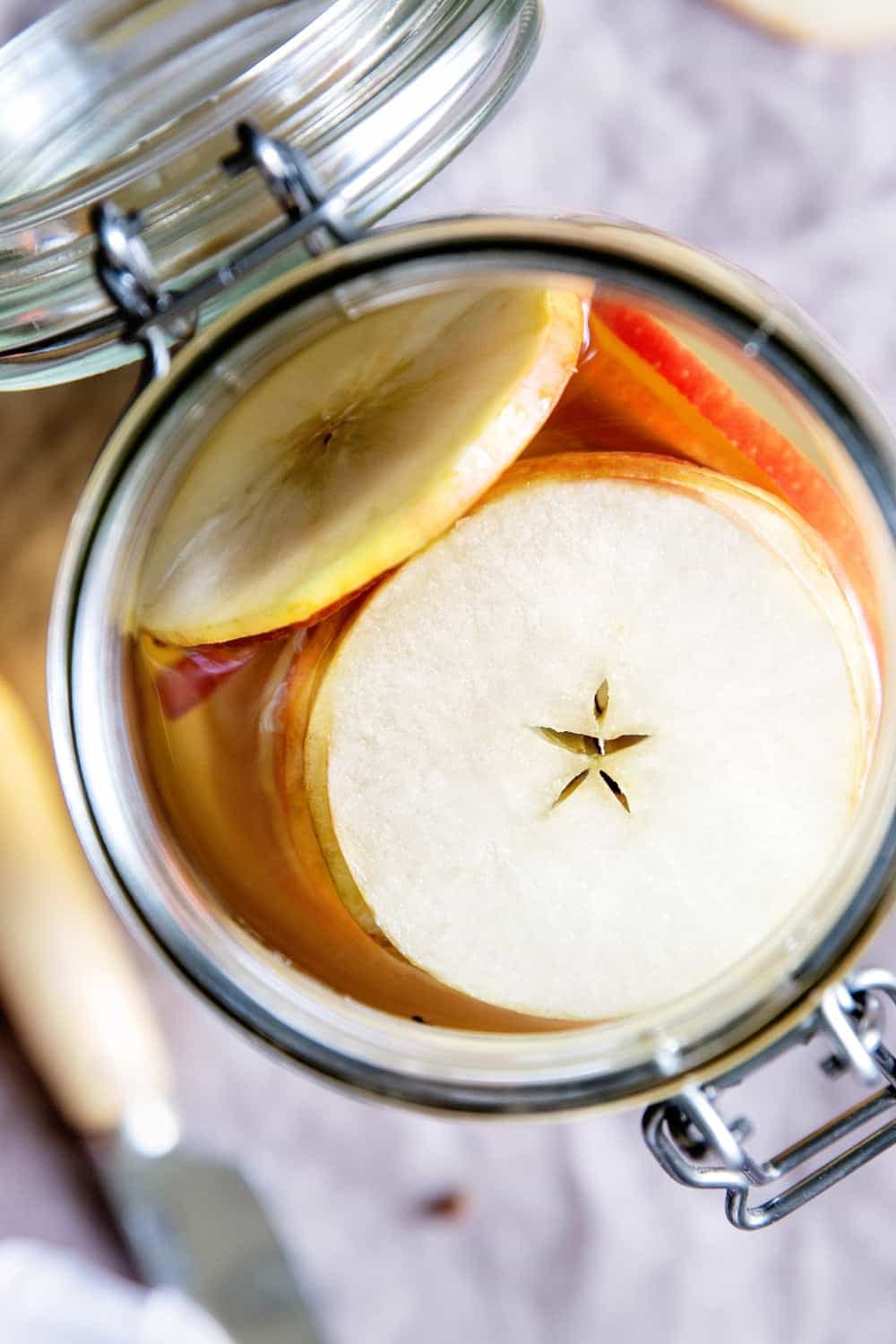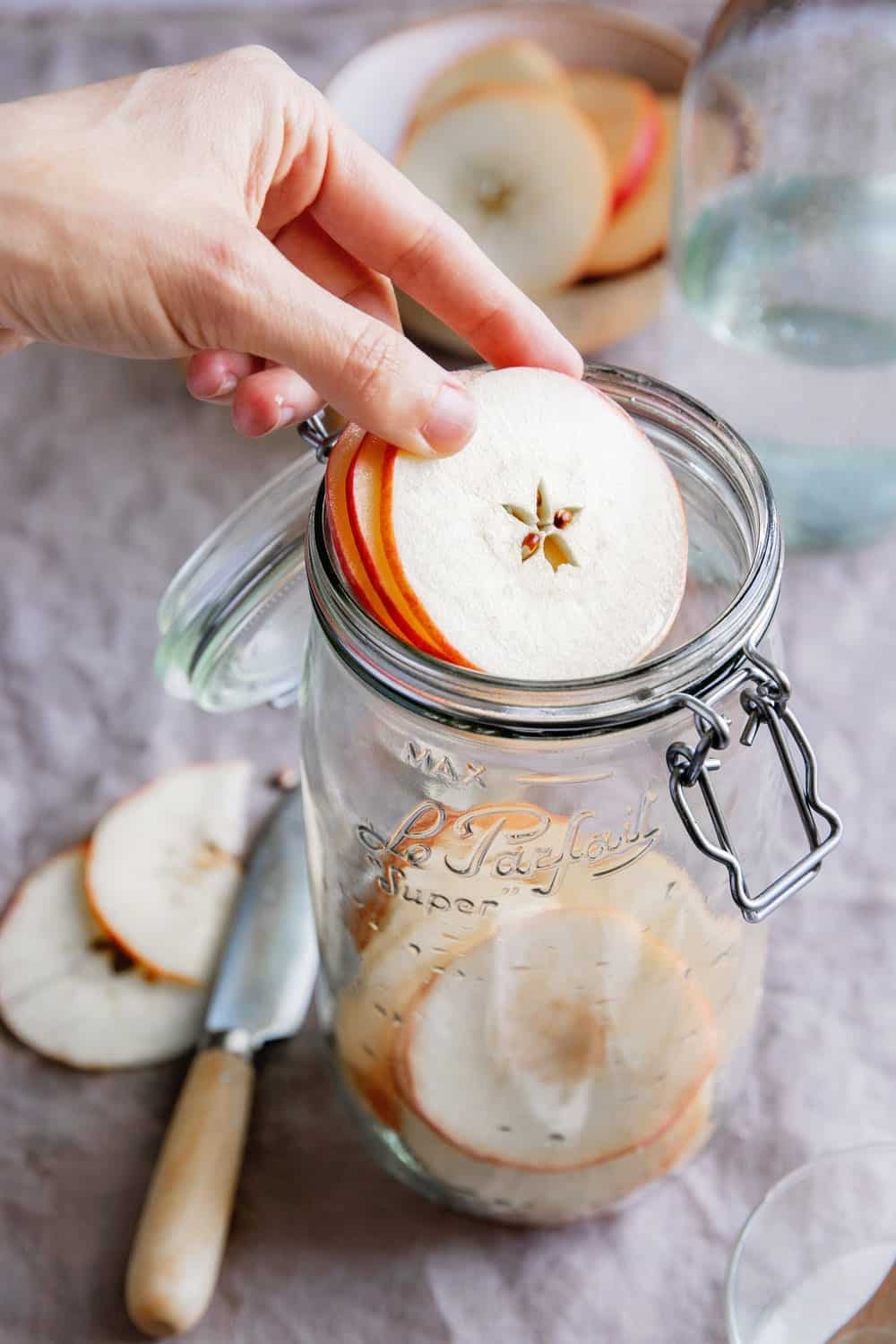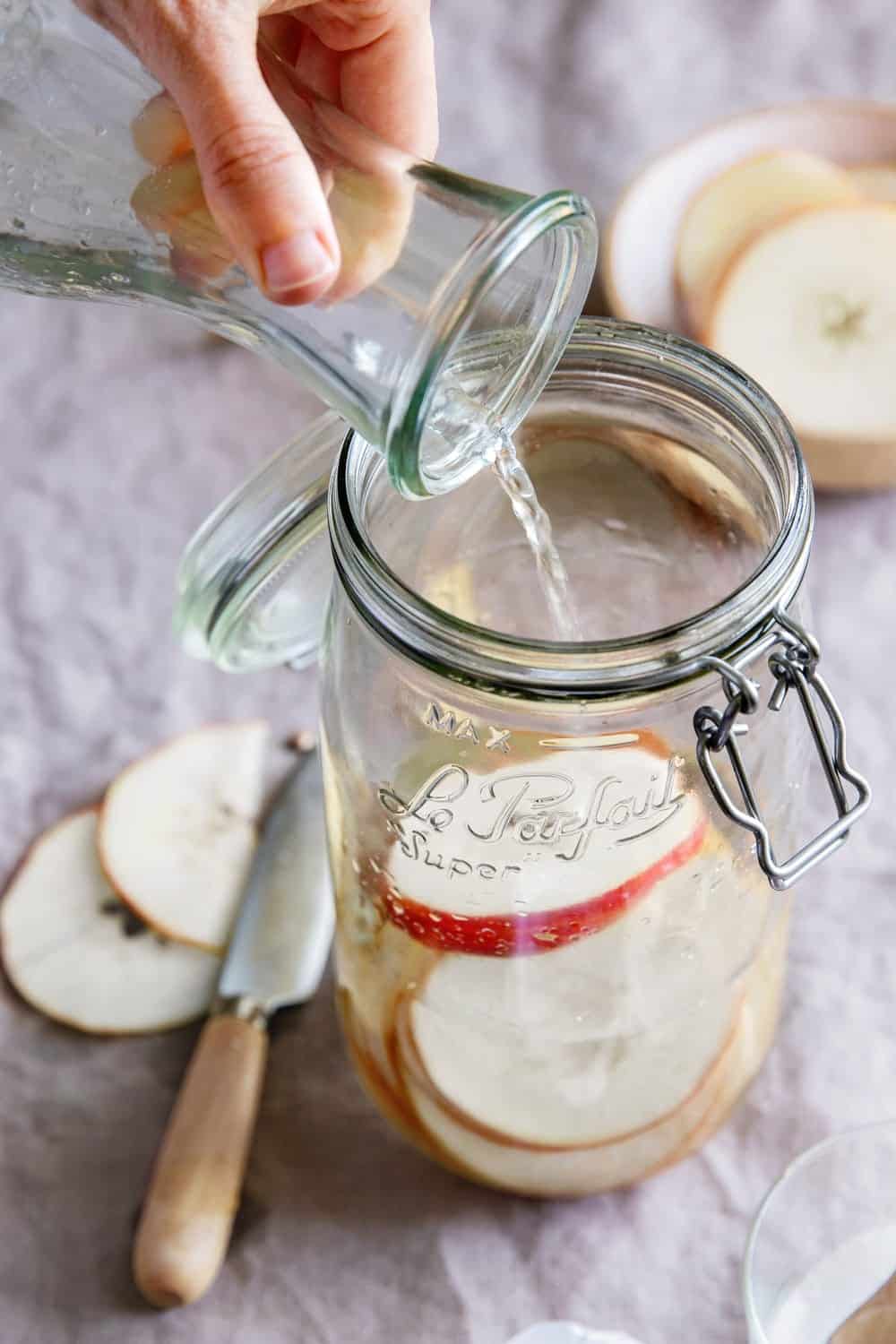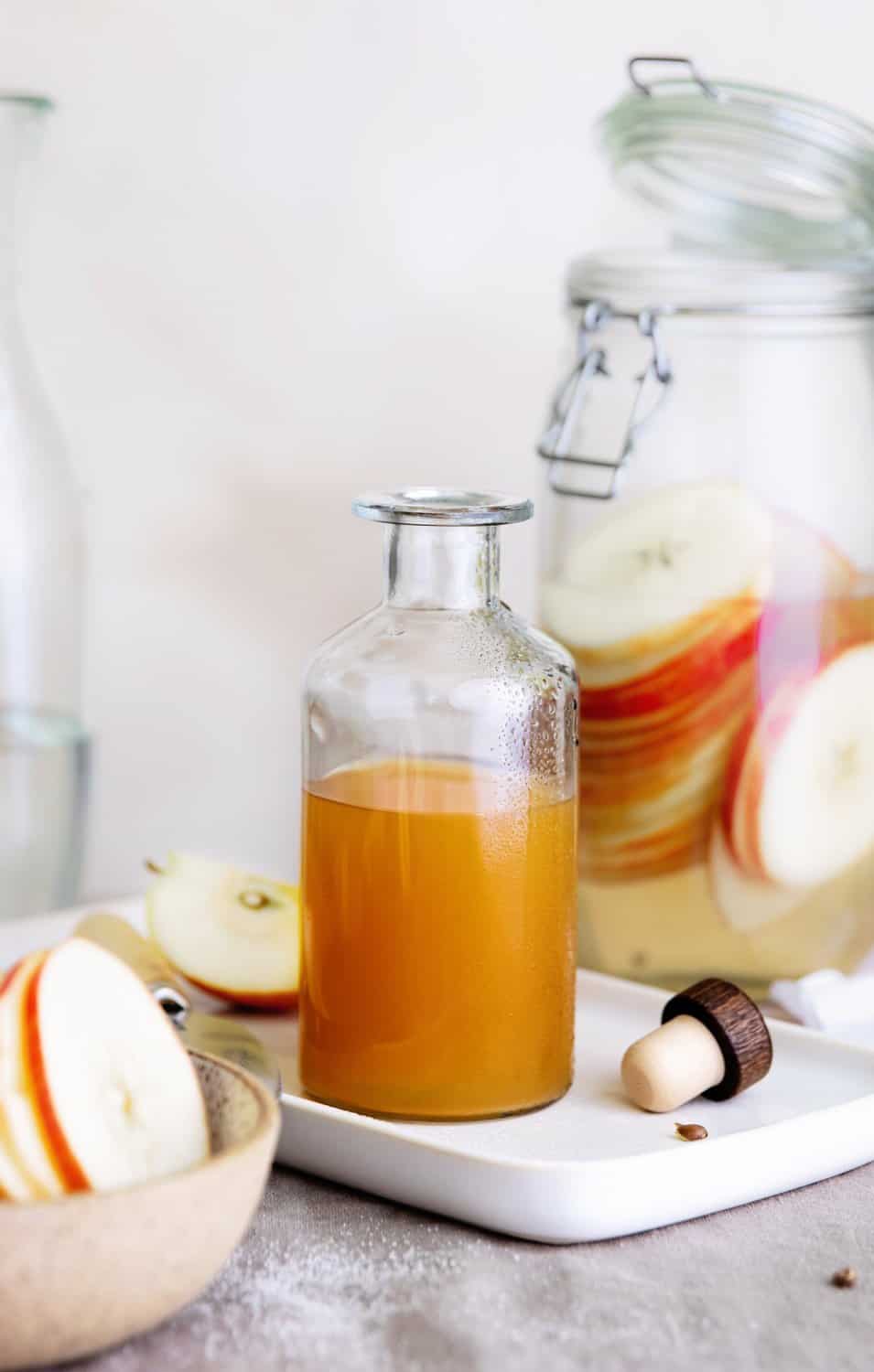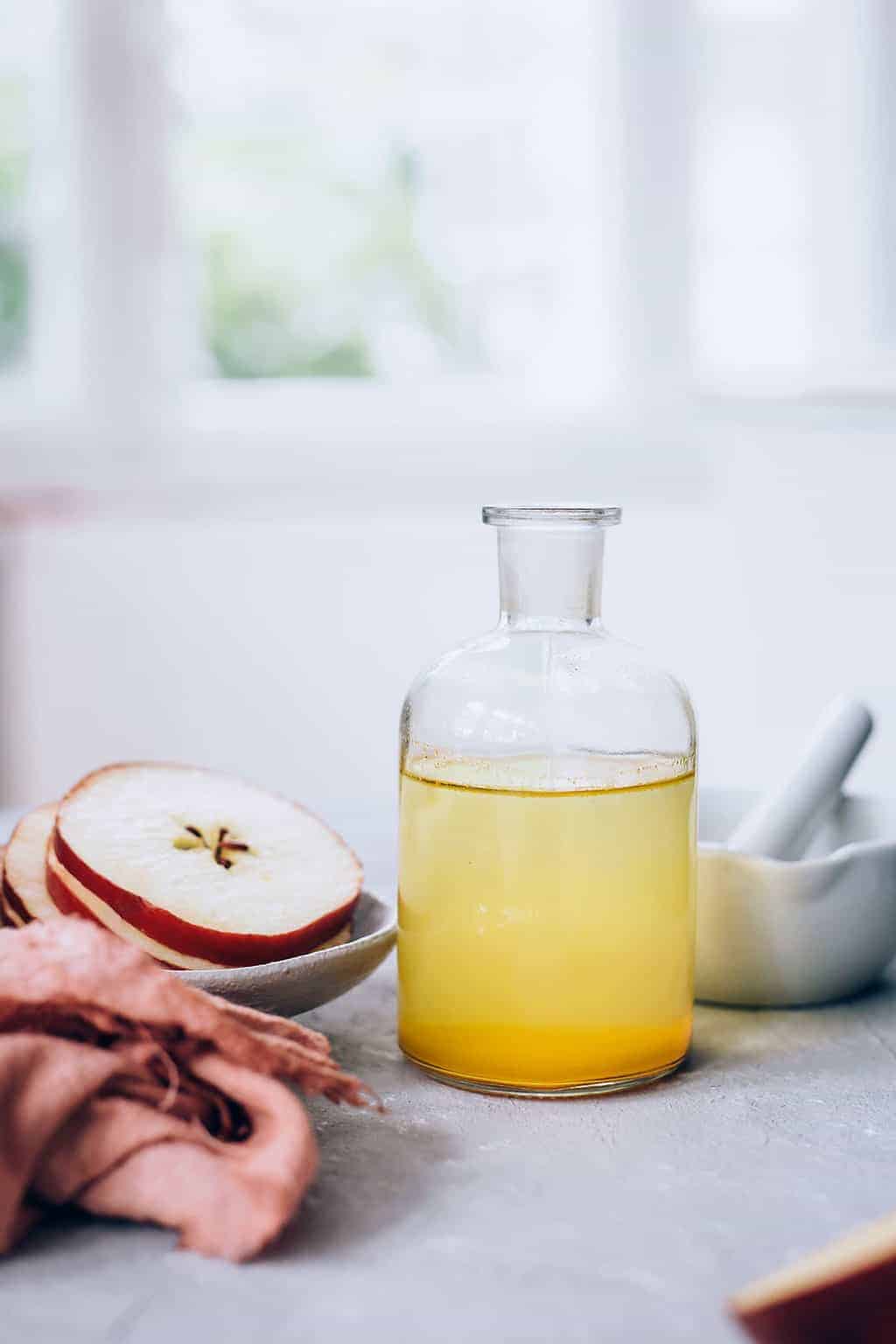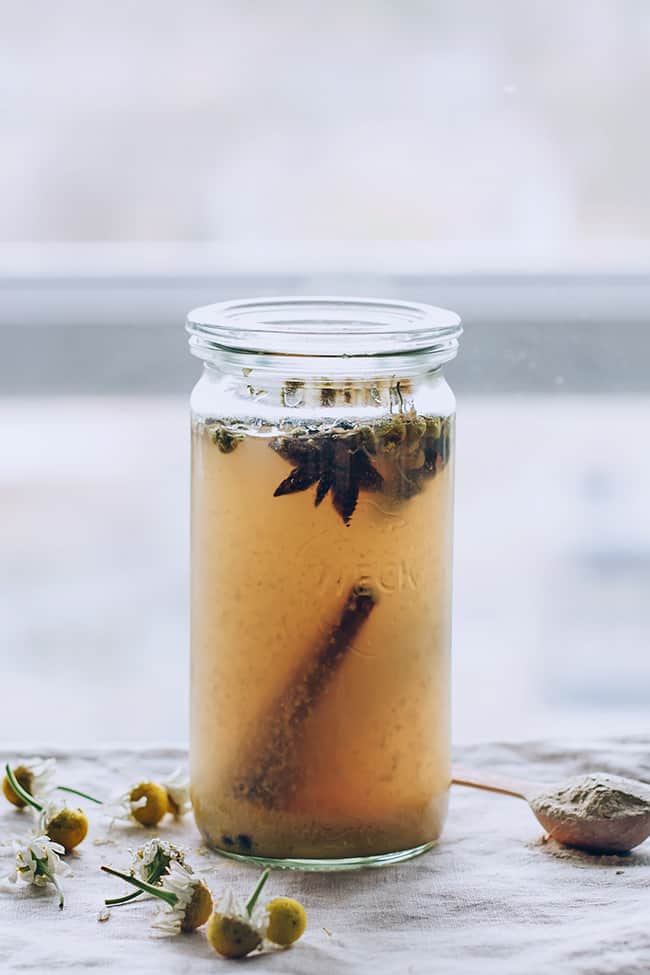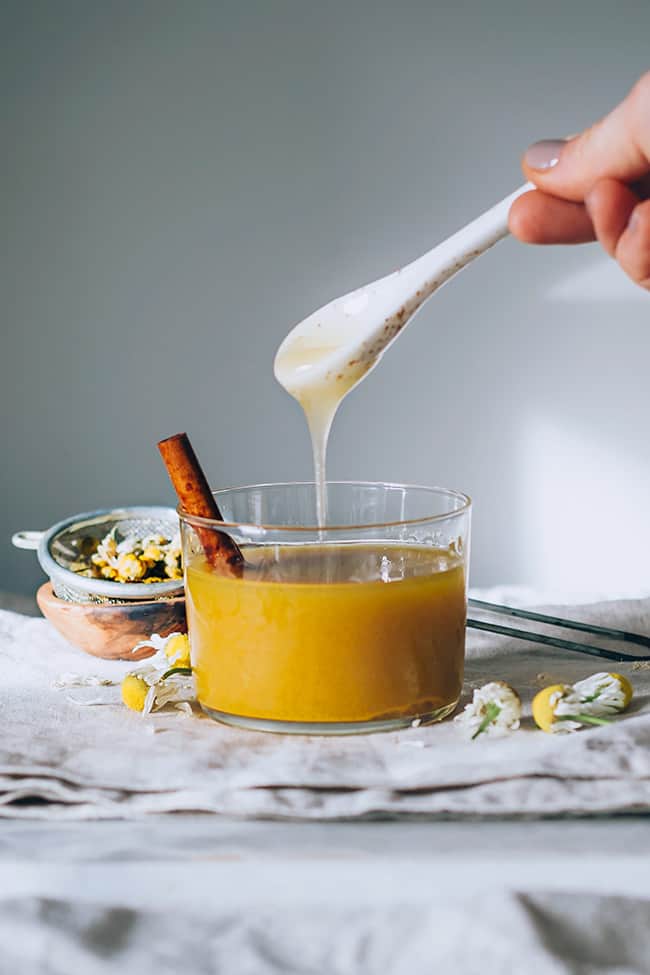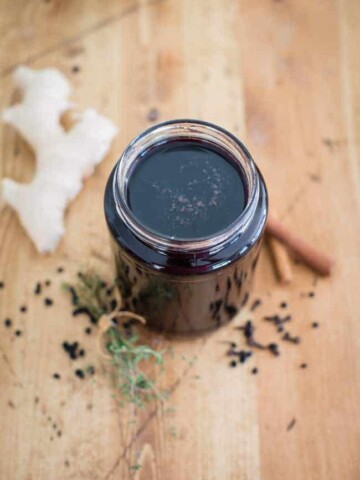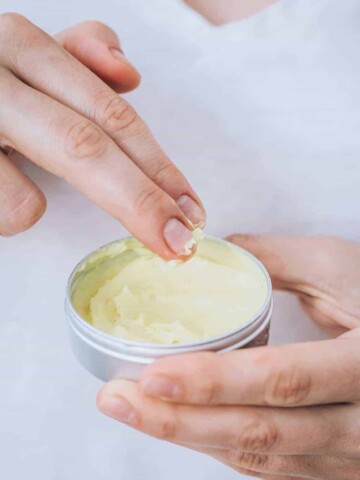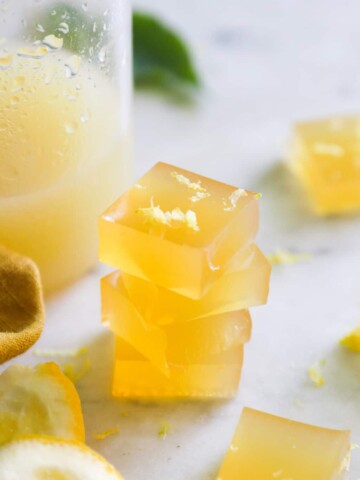Apple cider vinegar is a polarizing topic. Most people I know gag at the mere sight (uh, smell) of it. Just about everyone else loves the stuff. I personally consider myself a rare tweener: I don’t love it but I can drink it without making a face. I’ll sip some before meals, toss it in salad dressings and make a wicked cold remedy with it, while constantly reminding myself that it's good for me.
But just like other fermented drinks, I’ve found that homemade apple cider vinegar is better and cheaper than the store bought kind. Plus you don’t need a starter culture or any fancy equipment to make it. Just a jar, apples and some sugar water. Seriously, it’s fool proof.
And if that's not enough, we'll even show you how to use your freshly brewed ACV in a healing apple cider vinegar elixir!
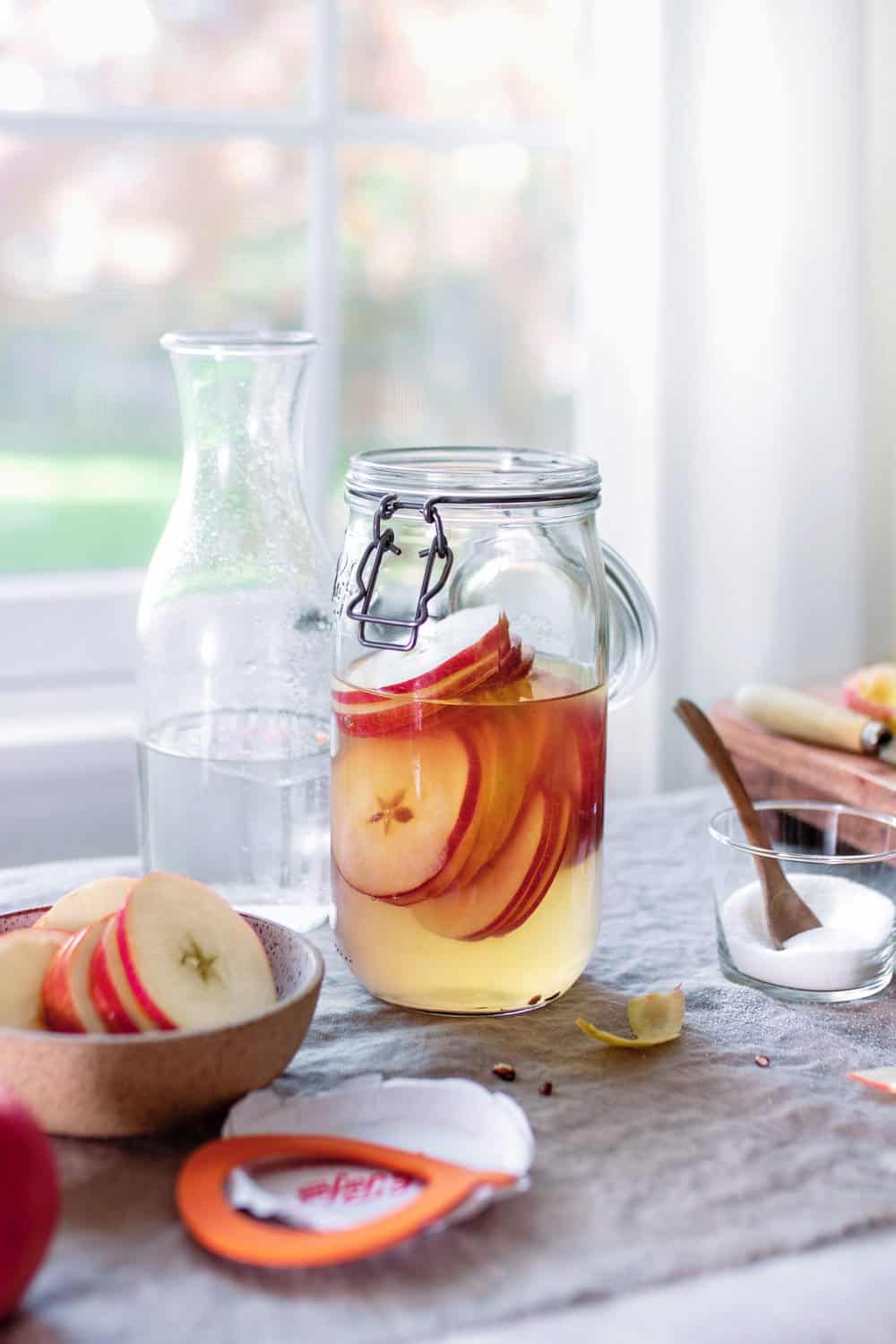
Benefits of Homemade Apple Cider Vinegar
I hate to break it to you, but a lot of the ACV you find in supermarkets is pasteurized and highly processed. That means that all of the beneficial bacteria is long gone before it even gets to you. And while it still works well for cleaning, you can kiss all the health benefits goodbye.
You'll get the 'mother'
On the other hand, you may have noticed that some apple cider vinegar brands say "with the mother" on the bottle. All that really means is that the vinegar is unpasteurized and still contains the "mother" culture, which is a combination of yeast and bacteria created during the fermentation process.
The mother culture looks like a cloudy, stringy substance that settles at the bottom of the bottle, but it contains enzymes and beneficial bacteria that provide a plethora of home, health and beauty benefits.
You'll get the health benefits
When consumed, it can help your stomach break down food and reduce acid reflux afterwards. AVC diluted in water can even help with an upset tummy or bloating as well.
You'll get the beauty benefits
When used topically, it helps balance pH and soothe skin irritation in the form of dandruff, eczema and acne.
You'll save money
But buying the raw, unfiltered stuff can get pricey quickly. Especially if you’re using it for everything from homemade beauty recipes to cold and flu remedies. Thankfully making your own ACV is dead simple.
How To Make Your Own Apple Cider Vinegar
While you can always buy a cheap bag of organic apples from the store, you can also make vinegar from apple scraps.
Every time you eat apples, toss the leftover peels and cores in a food safe container in your freezer. When you have enough to make vinegar (about 6 apples worth), simply let them thaw on the kitchen counter before tossing them in a jar with sugar water. Place the jar in a warm, dark pantry for several weeks to kick off fermentation and turn the apples into vinegar.
You will know your vinegar is ready when you see a dark, cloudy foam in the jar. This is “the mother” which makes raw vinegar so good for you.
Ready to drink apple cider vinegar? Enjoy it straight or dilute a tablespoon in water for maximum health benefits.
DIY Apple Cider Vinegar Recipe
—3 whole organic apples or scraps from about 6 apples
—2 tablespoons sugar (raw or white is fine)
—Filtered water to cover – I used about 3 cups but you might need more or less depending on the size of your container
—Large glass jar
—Paper towel and a rubber band
—Fermentation stone or cabbage leaves to keep the apples submerged (optional)
Instructions
Step 1 | Roughly cut your apples
Wash and chop your apples into large pieces. Place them in a clean jar.
Step 2 | Dissolve sugar in water
Mix the sugar with 1 cup water and pour on top of the apples. Add more water so that apples are covered by about an inch.
Depending on how small your apple chunks are, you might find that some pieces float to the top. If they continue floating after 24 hours, use a fermentation stone or large cabbage leaves to weigh them down and keep them fully submerged. This will prevent mold from forming in your vinegar.
Step 3 | Cover the jar with fabric or a towel
To keep fruit flies away, cover the jar with a paper towel and secure it with a rubber band.
Step 4 | Place in warm, dark spot to ferment
Place the jar in a warm pantry for 2 weeks, checking regularly for mold or other growth. If you do find mold, you'll need to toss out the mix and start over.
Step 5 | Strain the liquid and continue fermenting
Strain out the liquid and discard the apple pieces. Return the liquid to the same jar. Cover it again and place it back in the pantry.
Continue fermenting for an additional 4 weeks, stirring every few days. After 4 weeks, taste test your vinegar. Once it reaches an acidity you like, transfer to a bottle and begin using it.
How To Store Homemade Vinegar
Once you've made your homemade apple cider vinegar, it's important to store it properly to maintain its quality and freshness. Improper storage can lead to an overgrowth of harmful bacteria or mold, which can spoil the vinegar and make it unsafe to consume.
Store in a cool, dark place. Apple cider vinegar should be stored in a cool, dark place away from sunlight and heat, which can cause the vinegar to break down and lose its flavor. A pantry, cupboard or refrigerator are ideal spots.
Use airtight glass containers. Avoid storing the vinegar in plastic containers as the acid in the vinegar can react with the plastic and leach harmful chemicals into the vinegar.
Label and date your brew. Like with any homemade concoction, you'll want to label your homemade apple cider vinegar with the date and a quick description. This will help you keep track of its freshness and ensure that you use it before it goes bad.
Throw out after a year. Properly stored apple cider vinegar can last up to six months to a year. Over time, the vinegar may start to lose its flavor and acidity. If you notice any changes in color, texture, or smell, discard the vinegar.
How to Use Homemade Apple Cider Vinegar
The list is seriously endless, but here are a few simple ways to use your homemade ACV:
1. Salad dressing
Use apple cider vinegar as a base for a healthy, homemade salad dressing. Mix together apple cider vinegar, olive oil, honey, and Dijon mustard for a tasty and tangy dressing that's perfect for a fresh salad.
2. Hair rinse
Vinegar is a natural clarifier, which means it helps remove buildup from hair products and minerals from hard water that can leave your hair feeling dull and lifeless. This can help to give your hair a natural shine and volume, reduce dandruff and promote healthy hair growth.
Dilute apple cider vinegar with water and use it as a hair rinse or add it to a clarifying shampoo to help restore the pH balance of your scalp and hair.
3. All-purpose cleaner
Apple cider vinegar has a high acidity level, which gives it powerful antimicrobial properties that can kill many types of harmful bacteria. ACV is also an effective deodorizer that can neutralize odors caused by bacteria and other sources.
Mix equal parts apple cider vinegar and water in a spray bottle to create an all-purpose cleaner. Use it to clean countertops, floors, and other surfaces in your home.
4. Marinade
Vinegar's tangy and slightly sweet flavor adds depth and complexity to meat, fish, and vegetables dishes. Not to mention, the acidity of the vinegar can help tenderize tough cuts of meat by breaking down the connective tissues and fibers.
Combine apple cider vinegar, olive oil, garlic, and herbs for a delicious marinade that will add flavor to any dish.
5. Skin toner
ACV can help balance the pH of your skin, reduce acne, and promote a healthy glow. Simply mix equal parts apple cider vinegar and water and use it as a homemade toner for your skin.
6. Cold-fighting wellness elixir
You can infused apple cider vinegar with healing ingredients like cinnamon, chamomile, calendula and adaptogens. While it’s true that it takes some time (up to two weeks!) to obtain a lovely flavored ACV with a boost of healing herbs, it’s worth it for a simple home remedy to keep on hand for cold season.
Pectin nourishes the microbiome, which helps maintain a strong immune system and increases the vitality of the whole body. Full recipe below!
Homemade Vinegar FAQ
What equipment do I need to make apple cider vinegar at home?
To make your ACV, you'll need a large jar, cheesecloth or coffee filter, rubber band, and a fermentation weight (optional but not necessary).
Can I use any type of apple to make apple cider vinegar?
To keep your ACV as clean and nutritious as possible, you'll want to use organic apples that are free from pesticides and other chemicals. And while you're free to use any variety of apples, tart apples, like Granny Smith or Pink Lady apples, are preferred as they have a higher acid content.
How long does it take to make apple cider vinegar at home?
The fermentation process typically takes about 4-6 weeks, but the time may vary depending on external factors such as climate or air temperature.
How do I know when my apple cider vinegar is ready?
When it's ready, your ACV will have a tangy, acidic taste and a strong vinegar smell. To get specific, you can also test the acidity level using a pH test strip, which should read between 2.5-3.5.
Can I use my homemade apple cider vinegar for cooking and cleaning?
Yes, absolutely! Homemade vinegar can be used as a salad dressing, marinade, or as an ingredient in sauces and soups. It can also be used as a natural cleaning solution for your home.
Can I infuse apple cider vinegar?
Yes! Just combine apple cider vinegar and infusion ingredients in a Mason jar, cover and shake to combine, then let infuse at room temperature for two weeks. See the recipe below for chamomile and cinnamon infused ACV that you can turn into a cold-fighting tea.
📖 Recipe
Cold-Fighting Elixir + Chamomile-Infused Apple Cider Vinegar
Equipment
- 16-ounce mason jar
Ingredients
For the Infused Apple Cider Vinegar:
- 3 cups unfiltered apple cider vinegar
- 3 cinnamon sticks
- 1 teaspoon cloves
- 2 anise stars
- 1 tablespoon dried chamomile
For the Healing Elixir:
- 2 tablespoons infused apple cider vinegar
- 1 small turmeric root peeled and grated
- ½- inch ginger piece peeled and grated
- Juice from 1 lemon
- 2 tablespoons organic raw honey
- 2 crushed black peppercorns
- 3 cups purified warm water not boiling, to avoid killing the good bacteria
Instructions
- Place the apple cider vinegar and the healing ingredients in a Mason jar, cover and shake to combine, then let infuse at room temperature for 2 weeks.
- Strain and transfer into a glass bottle with lid.
- To prepare the healing drink, mix the honey with the turmeric, ginger, lemon juice, infused ACV and crushed black pepper in a small bowl.
- Divide the mixture into 2 mugs, then pour the warm water over it.
- Mix and drink warm.

